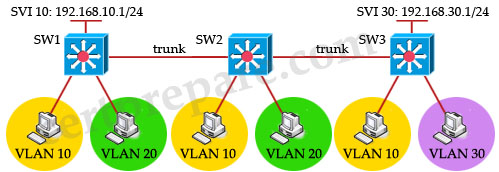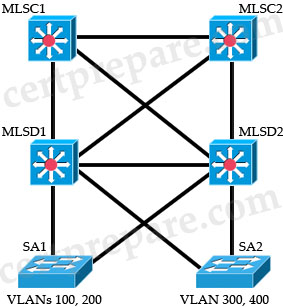InterVLAN Routing 2
Here you will find answers to InterVLAN Routing questions – Part 2
Question 1
Refer to the exhibit.
| Switch# configure terminal Switch(config)# interface gigabitethernet0/2 Switch(config-if)# switchport autostate exclude Switch(config-if)# exit |
You have configured an interface to be an SVI for Layer 3 routing capabilities. Assuming that all VLANs have been correctly configured, what can be determined?
A. Interface gigabitethemet0/2 will be excluded from Layer 2 switching and enabled for Layer 3 routing.
B. The command switchport autostate exclude should be entered in global configuration mode, not subinterface mode, to enable a Layer 2 port to be configured for Layer 3 routing.
C. The configured port is excluded in the calculation of the status of the SVI.
D. The interface is missing IP configuration parameters; therefore, it will only function at Layer 2.
Answer: C
Explanation
An SVI is considered “up” as long as at least one port in its associated VLAN is active and forwarding. If all ports in the VLAN are down, the interface goes down to avoid creating a routing black hole. You might not want the status of a particular port (one not connected to a host) to affect the SVI’s status. The switchport autostate exclude command enables you to exclude the access ports/trunks in defining the status of the SVI (up or down) even if it belongs to the same VLAN; for example when traffic analyzers are attached to a host. They will stay up, but are just passive monitors, so if all other devices in the VLAN go down – this port would prevent the VLAN from going down, so autostate exclude is applied to allow the VLAN to still go down.
(Reference: http://www.cisco.com/en/US/docs/switches/lan/catalyst4500/12.2/37sg/configuration/guides/l3_int.html)
Question 2
Which two steps are necessary to configure inter-VLAN routing between multilayer switches? (Choose two)
A. Configure a dynamic routing protocol.
B. Configure SVI interfaces with IP addresses and subnet masks.
C. Configure access ports with network addresses.
D Configure switch ports with the autostate exclude command.
E. Document the MAC addresses of the switch ports.
Answer: A B
Explanation
A multilayer switch can use a switched virtual interface (SVI) to provide inter-VLAN routing rather than use an external router.
When we have some multilayer switches (MLS) for inter-VLAN routing we should configure a dynamic routing protocol (OSPF is currently the most popular one). For example in the topology below:

We have to configure interVLAN routing between VLAN 10 & 30 so that hosts attached to SW1 in VLAN 10 can talk to hosts attached to SW3 in VLAN 30. Of course we can use static routes but it is not recommended, especially when we add more Layer 3 Switches or more VLANs in the future.
Question 3
When configuring a routed port on a Cisco multilayer switch, which configuration task is needed to enable that port to function as a routed port?
A. Enable the switch to participate in routing updates from external devices with the router command in global configuration mode.
B. Enter the no switchport command to disable Layer 2 functionality at the interface level.
C. Each port participating in routing of Layer 3 packets must have an IP routing protocol assigned on a per-interface level.
D. Routing is enabled by default on a multilayer switch, so the port can become a Layer 3 routing interface by assigning the appropriate IP address and subnet information.
Answer: B
Question 4
Refer to the exhibit, which is from a Cisco Catalyst 3560 Series Switch.
Switch#configure terminal
Switch(config)#interface gigabitethernet0/2
Switch(config-if)#no switchport
Switch(config-if)#ip address 192.20.135.21 255.255.255.0
Switch(config-if)#no shutdown
Which statement about the Layer 3 routing functionality of the interface is true?
A. The interface is configured correctly for Layer 3 routing capabilities.
B. The interface needs an additional configuration entry to enable IP routing protocols.
C. Since the interface is connected to a host device, the spanning-tree portfast command must be added to the interface.
D. An SVI interface is needed to enable IP routing for network 192.20.135.0.
Answer: A
Question 5
Refer to the exhibit

For the configuration shown, which is the recommended method of providing inter VLAN routing?
A. Determine which switch is the root bridge then connect a router on a stick to it
B. Configure SVIs on the core switches
C. Configure SVIs on the distribution switches
D. Configure SVIs on the access layer switches
Answer: C
Explanation
Cisco recommends using layer 3 routing at the distribution layer of the multilayer switched network to terminate local VLANS, isolate network problems, and avoid access layer issues from affecting the core -> SVIs should be configured on Distribution switches.


